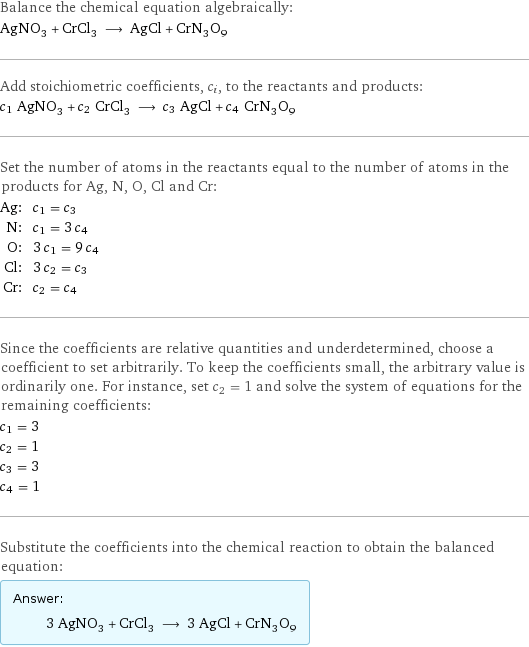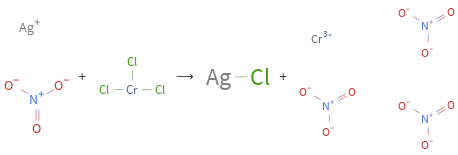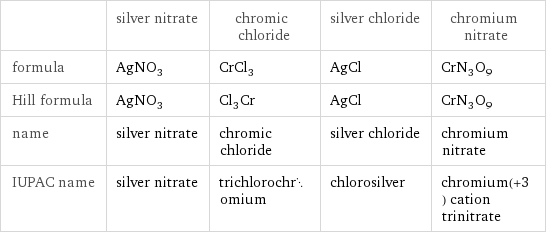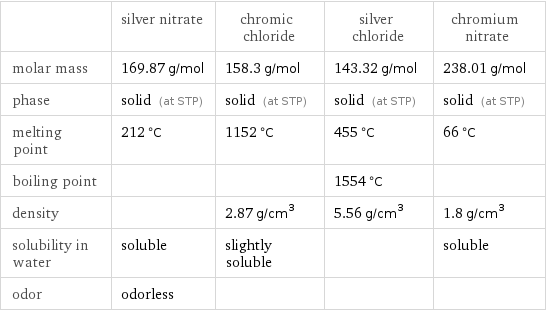Input interpretation

AgNO_3 silver nitrate + CrCl_3 chromic chloride ⟶ AgCl silver chloride + CrN_3O_9 chromium nitrate
Balanced equation

Balance the chemical equation algebraically: AgNO_3 + CrCl_3 ⟶ AgCl + CrN_3O_9 Add stoichiometric coefficients, c_i, to the reactants and products: c_1 AgNO_3 + c_2 CrCl_3 ⟶ c_3 AgCl + c_4 CrN_3O_9 Set the number of atoms in the reactants equal to the number of atoms in the products for Ag, N, O, Cl and Cr: Ag: | c_1 = c_3 N: | c_1 = 3 c_4 O: | 3 c_1 = 9 c_4 Cl: | 3 c_2 = c_3 Cr: | c_2 = c_4 Since the coefficients are relative quantities and underdetermined, choose a coefficient to set arbitrarily. To keep the coefficients small, the arbitrary value is ordinarily one. For instance, set c_2 = 1 and solve the system of equations for the remaining coefficients: c_1 = 3 c_2 = 1 c_3 = 3 c_4 = 1 Substitute the coefficients into the chemical reaction to obtain the balanced equation: Answer: | | 3 AgNO_3 + CrCl_3 ⟶ 3 AgCl + CrN_3O_9
Structures

+ ⟶ +
Names

silver nitrate + chromic chloride ⟶ silver chloride + chromium nitrate
Equilibrium constant
![Construct the equilibrium constant, K, expression for: AgNO_3 + CrCl_3 ⟶ AgCl + CrN_3O_9 Plan: • Balance the chemical equation. • Determine the stoichiometric numbers. • Assemble the activity expression for each chemical species. • Use the activity expressions to build the equilibrium constant expression. Write the balanced chemical equation: 3 AgNO_3 + CrCl_3 ⟶ 3 AgCl + CrN_3O_9 Assign stoichiometric numbers, ν_i, using the stoichiometric coefficients, c_i, from the balanced chemical equation in the following manner: ν_i = -c_i for reactants and ν_i = c_i for products: chemical species | c_i | ν_i AgNO_3 | 3 | -3 CrCl_3 | 1 | -1 AgCl | 3 | 3 CrN_3O_9 | 1 | 1 Assemble the activity expressions accounting for the state of matter and ν_i: chemical species | c_i | ν_i | activity expression AgNO_3 | 3 | -3 | ([AgNO3])^(-3) CrCl_3 | 1 | -1 | ([CrCl3])^(-1) AgCl | 3 | 3 | ([AgCl])^3 CrN_3O_9 | 1 | 1 | [CrN3O9] The equilibrium constant symbol in the concentration basis is: K_c Mulitply the activity expressions to arrive at the K_c expression: Answer: | | K_c = ([AgNO3])^(-3) ([CrCl3])^(-1) ([AgCl])^3 [CrN3O9] = (([AgCl])^3 [CrN3O9])/(([AgNO3])^3 [CrCl3])](../image_source/3db8c484318d603d29c91fc14db5f5de.png)
Construct the equilibrium constant, K, expression for: AgNO_3 + CrCl_3 ⟶ AgCl + CrN_3O_9 Plan: • Balance the chemical equation. • Determine the stoichiometric numbers. • Assemble the activity expression for each chemical species. • Use the activity expressions to build the equilibrium constant expression. Write the balanced chemical equation: 3 AgNO_3 + CrCl_3 ⟶ 3 AgCl + CrN_3O_9 Assign stoichiometric numbers, ν_i, using the stoichiometric coefficients, c_i, from the balanced chemical equation in the following manner: ν_i = -c_i for reactants and ν_i = c_i for products: chemical species | c_i | ν_i AgNO_3 | 3 | -3 CrCl_3 | 1 | -1 AgCl | 3 | 3 CrN_3O_9 | 1 | 1 Assemble the activity expressions accounting for the state of matter and ν_i: chemical species | c_i | ν_i | activity expression AgNO_3 | 3 | -3 | ([AgNO3])^(-3) CrCl_3 | 1 | -1 | ([CrCl3])^(-1) AgCl | 3 | 3 | ([AgCl])^3 CrN_3O_9 | 1 | 1 | [CrN3O9] The equilibrium constant symbol in the concentration basis is: K_c Mulitply the activity expressions to arrive at the K_c expression: Answer: | | K_c = ([AgNO3])^(-3) ([CrCl3])^(-1) ([AgCl])^3 [CrN3O9] = (([AgCl])^3 [CrN3O9])/(([AgNO3])^3 [CrCl3])
Rate of reaction
![Construct the rate of reaction expression for: AgNO_3 + CrCl_3 ⟶ AgCl + CrN_3O_9 Plan: • Balance the chemical equation. • Determine the stoichiometric numbers. • Assemble the rate term for each chemical species. • Write the rate of reaction expression. Write the balanced chemical equation: 3 AgNO_3 + CrCl_3 ⟶ 3 AgCl + CrN_3O_9 Assign stoichiometric numbers, ν_i, using the stoichiometric coefficients, c_i, from the balanced chemical equation in the following manner: ν_i = -c_i for reactants and ν_i = c_i for products: chemical species | c_i | ν_i AgNO_3 | 3 | -3 CrCl_3 | 1 | -1 AgCl | 3 | 3 CrN_3O_9 | 1 | 1 The rate term for each chemical species, B_i, is 1/ν_i(Δ[B_i])/(Δt) where [B_i] is the amount concentration and t is time: chemical species | c_i | ν_i | rate term AgNO_3 | 3 | -3 | -1/3 (Δ[AgNO3])/(Δt) CrCl_3 | 1 | -1 | -(Δ[CrCl3])/(Δt) AgCl | 3 | 3 | 1/3 (Δ[AgCl])/(Δt) CrN_3O_9 | 1 | 1 | (Δ[CrN3O9])/(Δt) (for infinitesimal rate of change, replace Δ with d) Set the rate terms equal to each other to arrive at the rate expression: Answer: | | rate = -1/3 (Δ[AgNO3])/(Δt) = -(Δ[CrCl3])/(Δt) = 1/3 (Δ[AgCl])/(Δt) = (Δ[CrN3O9])/(Δt) (assuming constant volume and no accumulation of intermediates or side products)](../image_source/87374a7c2195212dae6bcb1fab4e2537.png)
Construct the rate of reaction expression for: AgNO_3 + CrCl_3 ⟶ AgCl + CrN_3O_9 Plan: • Balance the chemical equation. • Determine the stoichiometric numbers. • Assemble the rate term for each chemical species. • Write the rate of reaction expression. Write the balanced chemical equation: 3 AgNO_3 + CrCl_3 ⟶ 3 AgCl + CrN_3O_9 Assign stoichiometric numbers, ν_i, using the stoichiometric coefficients, c_i, from the balanced chemical equation in the following manner: ν_i = -c_i for reactants and ν_i = c_i for products: chemical species | c_i | ν_i AgNO_3 | 3 | -3 CrCl_3 | 1 | -1 AgCl | 3 | 3 CrN_3O_9 | 1 | 1 The rate term for each chemical species, B_i, is 1/ν_i(Δ[B_i])/(Δt) where [B_i] is the amount concentration and t is time: chemical species | c_i | ν_i | rate term AgNO_3 | 3 | -3 | -1/3 (Δ[AgNO3])/(Δt) CrCl_3 | 1 | -1 | -(Δ[CrCl3])/(Δt) AgCl | 3 | 3 | 1/3 (Δ[AgCl])/(Δt) CrN_3O_9 | 1 | 1 | (Δ[CrN3O9])/(Δt) (for infinitesimal rate of change, replace Δ with d) Set the rate terms equal to each other to arrive at the rate expression: Answer: | | rate = -1/3 (Δ[AgNO3])/(Δt) = -(Δ[CrCl3])/(Δt) = 1/3 (Δ[AgCl])/(Δt) = (Δ[CrN3O9])/(Δt) (assuming constant volume and no accumulation of intermediates or side products)
Chemical names and formulas

| silver nitrate | chromic chloride | silver chloride | chromium nitrate formula | AgNO_3 | CrCl_3 | AgCl | CrN_3O_9 Hill formula | AgNO_3 | Cl_3Cr | AgCl | CrN_3O_9 name | silver nitrate | chromic chloride | silver chloride | chromium nitrate IUPAC name | silver nitrate | trichlorochromium | chlorosilver | chromium(+3) cation trinitrate
Substance properties

| silver nitrate | chromic chloride | silver chloride | chromium nitrate molar mass | 169.87 g/mol | 158.3 g/mol | 143.32 g/mol | 238.01 g/mol phase | solid (at STP) | solid (at STP) | solid (at STP) | solid (at STP) melting point | 212 °C | 1152 °C | 455 °C | 66 °C boiling point | | | 1554 °C | density | | 2.87 g/cm^3 | 5.56 g/cm^3 | 1.8 g/cm^3 solubility in water | soluble | slightly soluble | | soluble odor | odorless | | |
Units
